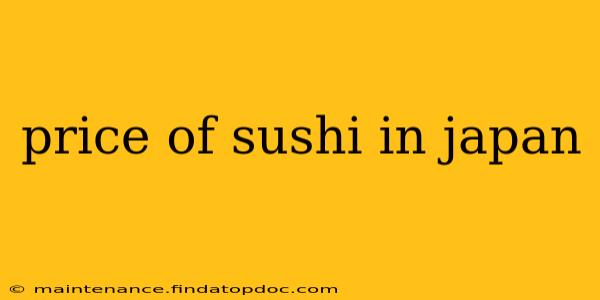The price of sushi in Japan can vary dramatically, ranging from incredibly affordable to extravagantly expensive. Understanding this range is crucial for planning your culinary adventures in the Land of the Rising Sun. This guide will explore the factors influencing sushi prices and offer insights into what you can expect to pay.
What factors affect the price of sushi in Japan?
Several key factors determine the cost of your sushi meal in Japan. These include:
- Location: Prices in major cities like Tokyo and Osaka tend to be higher than in smaller towns or rural areas. Tourist hotspots will also generally command higher prices.
- Type of Restaurant: A conveyor belt sushi restaurant (kaiten-zushi) will be significantly cheaper than a high-end, traditional sushi restaurant (edomae-zushi) with a master sushi chef.
- Ingredients: The quality and type of fish used significantly impact the price. Premium fish like bluefin tuna (maguro) will be considerably more expensive than other options. Seasonality also plays a role; certain fish are more expensive when they're in peak season.
- Preparation and Presentation: The skill and experience of the chef, as well as the presentation of the sushi, influence the overall cost. High-end restaurants often emphasize artistic presentation, adding to the price.
- Additional Items: Side dishes, drinks, and service charges will add to your total bill.
How much can I expect to pay for sushi in Japan?
Here's a breakdown of price ranges you might encounter:
Budget-Friendly Options (¥1,000 - ¥3,000 per person):
- Kaiten-zushi (Conveyor Belt Sushi): This is the most affordable option, with plates typically ranging from ¥100 to ¥500 each. You can easily enjoy a satisfying meal for under ¥3,000. However, the quality may vary.
Mid-Range Options (¥3,000 - ¥10,000 per person):
- Smaller, local sushi restaurants: These offer a good balance between price and quality. Expect to pay around ¥3,000 to ¥7,000 for a decent meal.
- Slightly more upscale kaiten-zushi: Some conveyor belt sushi restaurants offer higher-quality ingredients at a slightly higher price point.
High-End Options (¥10,000+ per person):
- Edomae-zushi (Traditional Sushi Restaurants): These restaurants offer exceptional quality fish and expert craftsmanship, with prices often exceeding ¥10,000 per person and sometimes reaching tens of thousands of yen for a full omakase (chef's choice) experience.
What is Omakase, and how much does it cost?
Omakase is a Japanese dining experience where you leave the menu selection entirely to the chef. It's a chance to sample the chef's best creations and often features the most premium ingredients available. The cost of omakase can vary greatly depending on the restaurant, but you can easily expect to pay ¥15,000 or more per person, and significantly more in top-tier establishments.
Is sushi expensive in Japan compared to other countries?
While you can find affordable sushi in Japan, the high-end options are often significantly more expensive than similar offerings in many other countries. This is due to the high quality of the ingredients, the skill of the chefs, and the overall dining experience.
Where can I find affordable sushi in Japan?
Look for smaller, local sushi restaurants away from major tourist areas. Kaiten-zushi (conveyor belt sushi) restaurants are also an excellent option for budget-conscious travelers. Don't be afraid to venture off the beaten path to discover hidden gems.
What is the average cost of a sushi dinner in Japan?
The average cost of a sushi dinner in Japan is highly dependent on your choice of restaurant and the type of sushi you order. It can range from a budget-friendly ¥2,000 to an extravagant ¥50,000 or more. A reasonable estimate for a satisfying meal at a mid-range restaurant would be between ¥4,000 and ¥8,000.
This guide provides a general overview. Always check menus and prices before ordering to avoid any unexpected costs. Enjoy your sushi experience in Japan!
